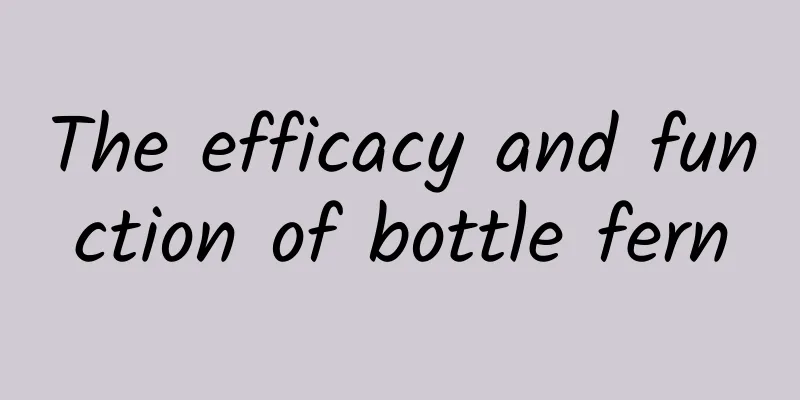The efficacy and function of bottle fern

|
Bottle fern is a very nutritious and precious medicinal material. Eating bottle fern regularly can have very good effects and functions. So how should we eat bottle fern? What specific benefits can eating bottle fern bring to our body? We need to understand some professional knowledge of bottle fern to answer these questions. 【English name】 Auriculed Bristlefern, Auriculed Filmy Fern 【Other name】 Hot water lotus [Source] Medicinal material source: the whole herb of the bottle fern of the Hymenopteris family. [Original morphology] Medium-sized epiphytic fern, plant height 15-30cm. The rhizome is hard, gray-brown, long and horizontal, covered with dark-brown shiny multicellular nodular hairs, which fall off later; the buds between the leaf axils are densely covered with nodular hairs. The leaves are membranous, teleost, 3-5cm apart, arranged in 2 rows along the rhizome in the same plane, alternate, flat or slightly oblique; the petiole is 4-8mm long, with node-like hairs at the base, wingless or with narrow wings; the leaf blade is lanceolate, 15-30cm long and 3-5cm wide, the sporophylls are similar to the nutrient leaves, but narrower and more finely divided, once pinnate; the pinnae are 18-25 pairs, alternate, sessile; ovate-oblong, 2-3cm long, 1-1.5cm wide, closely connected, with broad auricles on the upper side of the base, and often covering the rachis, with irregular pinnae on the margins up to 1/2; the sterile lobes are narrowly oblong, 4-5mm long, 3-4mm wide, with blunt teeth at the apex, and each tooth has one small vein; the lobes of the sporophylls are often narrowed or have only one single vein; the veins are often dichotomously forked; the rachis has narrow wings or is nearly wingless. The sori are borne on the short pinnae towards the axis, with 10-14 on each pinna; the sori are narrowly tubular, 2-2.5mm long, with a truncated mouth that is not swollen and has shallow blunt teeth; the sori protrudes outside the mouth and is about 4mm long. [Habitat distribution] Ecological environment: Growing on tree trunks or shady and wet rocks by streams at an altitude of 500-2700m. 【Nature and flavor】 slightly bitter; neutral; 【Meridian】 Liver meridian 【Functions and indications】 Promotes tissue regeneration and stops bleeding. Major trauma bleeding 【Usage and Dosage】 For external use: take appropriate amount, grind the dry product into powder and apply on the affected area; or crush the fresh product into powder and apply on the affected area. [Discussions by various scholars] "Xinhua Compendium of Materia Medica" The whole herb: slightly bitter in taste, neutral in nature. It has the function of stopping bleeding and promoting tissue regeneration. Used externally to treat bleeding from trauma and knife wounds. 【Excerpt】 Chinese Materia Medica The above is the introduction to bottle fern. I believe you will understand it after reading it. After knowing the effects and functions of bottle fern, you can adjust it according to your own physical condition. |
<<: The efficacy and function of Pili
>>: The efficacy and function of duckweed
Recommend
Breaking the world record! The Insight-HXMT satellite “saw”…
Recently, my country's Insight-HXMT team disc...
How many galaxies and suns are there in the universe? Scientific observations tell you the truth
This article is based on answering similar questi...
Humulus allergy
Grass is a traditional Chinese medicinal material...
【Creative Cultivation Program】Why aren’t chips made into round shapes?
Author: Zhou Lei Whether you are an electronics e...
What are the characteristics of the new generation of Long March carrier rocket?
The new generation of Long March launch vehicles ...
The efficacy and function of Clematis
Clematis is a kind of traditional Chinese medicin...
What’s more frightening than eating too much during the Chinese New Year is that the foods you thought were fat-reducing may actually be useless…
The New Year is coming soon There must be a lot o...
Carved for billions of years: the natural legend of Zhangshiyan landform
Author: Associate Researcher Zhang Wen Institute ...
Specific method of wormwood foot bath
I believe everyone is very familiar with mugwort....
Do you really understand colds?
When it comes to colds, everyone knows about it. ...
What are the effects and contraindications of Cordyceps
Eating more Cordyceps can effectively help us imp...
Is Poria Cocos edible?
Poria cocos is a very important medicinal ingredi...
The efficacy and function of pigeon droppings
What are the functions of pigeon droppings? As a ...
The stomach is most afraid of these "several things". One more thing will bring you closer to gastric cancer! Doctors: Many people are diagnosed at the late stage
Expert of this article: Hu Zhongdong, chief physi...
What are the effects and functions of Tong Tribulus terrestris
Tongji terrestris is a kind of leguminous plant. ...









